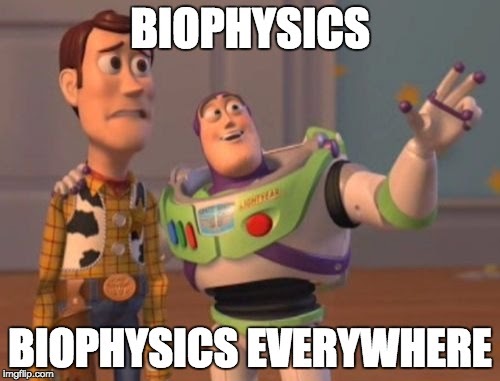Biophysical Society 2018 takeaways
With another Biophysical Society meeting over, I can’t help but bask in reflection at all the glorious science I got to see. More and more, biophysics is bridging the gap between basic science and translational research, where back-to-back speakers can be discussing a novel protein that nobody yet understands, followed by a speaker applying physical methods and imaging to better identify cells and tumors!
Reposting this image again because it’s so applicable:

In reflection, I wanted to post some thoughts/takeaways I had:
Phase separation is still an exciting new phenomena we don’t understand. It still boggles my mind to this day that molecules inside our cells undergo Liquid-Liquid Phase Separation (LLPS) behavior. What struck me the most is that we are not just seeing where they are important for function (à la la stress granules and the nucleolus) but also how LLPS can be a sign that something is broken. Simon Alberti presented excellent work showing how ALS mutations in certain FUS family proteins result in LLPS, which over long timescales could act as nucleation points for fibril formation normally associated with the disease. There’s so much more to learn about this fascinating phenomena and it’s importance to biology!
Lipids remain a mystery. I attended the “Lipid modified GTPases” symposium as a newcomer to the role of lipids in G protein signalling, and I am in awe of the role lipids can play in enhancing signalling sensitivity, and in lipid heterogeneity! There are so many emergent properties of lipid bilayers we don’t fully understand yet that it feels like there is a bit of a Gold Rush happening right now; No matter where we turn we are discovering some new critical aspect of lipids. They aren’t just important for “compartmentalization” but rather play important roles in regulating behavior and dynamics of signaling proteins!
On a humorous personal note: I saw my qualifying exam project! At the Washington University biophysics program, our qualifying exam consists of an “off-topic” oral presentation given on a subject not related to our thesis project (designed this way so our lab cannot just walk us through the qual with their expertise). I presented mine on using XFELs and powerful x-rays to study metalloenzymes and the redox cycle they undergo when carrying out electron/proton transport. Dr. Junko Yano at Lawrence Berkeley national lab presented an awesome symposium talk with that exact approach to study photosystem II! She took it even a step further showing that not only can XFELs be used to study the redox cycle of metal binding sites of enzymes, but with modern engineering advances, she also collected diffraction patterns at each of these redox states. That means we can both know the redox state of a metal, and observe what the metal binding site looks like! With that kind of insight, Dr. Yano was able to start understanding the transport “channel” inside of a protein and which residues may play a role!
There are so many other methods and findings I’m excited about, but for the sake of brevity and not writing a book chapter, I’ll stop at 3.